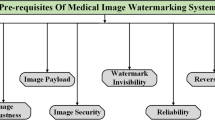Abstract
This work is a connecting link between the field of digital transmission and (3 Dimension) 3D watermarking. In fact, we propose in this paper a blind and robust watermarking algorithm for 3D multiresolution meshes. This data type, before being watermarked, is divided into GOTs (Group Of Triangles) using a spiral scanning method. At every instant, only one GOT is loaded into memory. It undergoes a wavelet transform. Embedding modifies the wavelet coefficients vector thus generated after being presented in a cylindrical coordinate system. After being watermarked, the current GOT will be released from memory to upload the next GOT. Information is coded using a turbo encoder to generate the codeword to be inserted. Once the entire mesh is scanned, the watermarked mesh is reconstructed. During extraction, the same steps are applied only on the watermarked mesh: our algorithm is then blind. Extracted data are decoded using Error-Correcting Code (turbocode) to correct errors that occurred. The results show that our algorithm preserves mesh quality even with a very large insertion rate while significantly minimizing used memory. Data extraction was done correctly despite the application of various attacks. Our algorithm is robust against most popular attacks such as similarity transformation, noise addition, smoothing, coordinate quantization, simplification and compression.


















Similar content being viewed by others
References
Che X, Gao Z (2012) Watermarking algorithm for 3d mesh based on multi-scale radial basis functions. International Journal of Parallel. Emerg Distrib Syst 27(2):133–141
Chrysafis C, Ortega A (2000) Line-based, reduced memory, wavelet image compression. IEEE Trans Image Process 9(3):378–389
Didi R, Shi J H (2012) Copyright protection for e-government document images. IEEE MultiMed 19(3):62–73
Elkefi A (2011) Compression des maillages 3d multiresolutions de grandes precisions. Sfax University, Ph.D. thesis
Hitendra G, Krishna K, Manish G, Suneeta A (2014) Uniform selection of vertices for watermark embedding in 3-d polygon mesh using ieee754 floating point representation. In: Fourth international conference on communication systems and network technologies, pp 788–792
Hu R, Xie L, Yu H, Ding B (2014) Applying 3d polygonal mesh watermarking for transmission, security protection through sensor networks. In: Mathematical problems in engineering 2014
Isenburg M, Gumholh S (2003) Out-of-core compression for gigantic polygon meshes. ACM Trans Graph 22(3):935–942
Kang H, Iwamura K (2014) Watermarking based on the difference of discrete cosine transform coefficients and an error-correcting code. In: Proceedings of the 1st international workshop on Information hiding and its criteria for evaluation, pp 9–17
Lamiaa B, Saleh H I, Abdelhalim M B (2015) Enhanced watermarking scheme for 3d mesh models. In: International conference on information technology, pp 612–619
Lin C H, Chao M W, Chen J Y, Yu C W, Hsu W Y (2012) Blind 3d model watermarking based on multi-resolution representation and fuzzy logic. Int J Comput Sci Inf Technol 4(1):117– 126
Lin CH, Chao MW, Chen J Y, Yu C W, Hsu W Y (2013) A high capacity distorsion free information hiding algorithm for 3d polygon models. Int J Innov Comput Inf Control 9(3):1321– 1335
Parisot C, Antonini M, Barlaud M (2001) 3d scan based wavelet transform for video coding. In: IEEE Fourth workshop on multimedia signal processing, pp 403–408
Roudet C, Payan F (2011) Remaillage semi-regulier pour les maillages surfaciques triangulaires : un etat de l art. Revue lectronique Francophone dInformatique Graphique 5(1):27– 40
Sayahi I, Elkefi A, Koubaa M, Amar C B (2015) A robust watermarking algorithm for 3d multiresolution meshes. In: International joint conference on computer vision, imaging and computer graphics theory and applications, pp 150–157
Shi J H, Didi R, Tianrui L, Terano T, Minyi G, Muhammad K K (2013) A blind image copyright protection scheme for e-government. Vis Commun Image Represent J 24(7):1099–1105
Shi J H, Didi R, Pingzhi F, Xian W, Muhammad K K (2014) An adaptive watermarking scheme for e-government document images. Multimed Tools Appl 72 (3):3085–3103
Su Z, Li W, Kong J, Dai Y W, Tang W (2013) Watermarking 3d capd models for topology models for topology verification. Comput-Aided Des 45 (7):1042–1052
Tamane SC, Deshmukh R R (2012) Watermarking 3d surface models into 3d surface models based on anfis. Adv Comput 2(3):29–34
Viterbi A (1971) Convolutional codes and their performance in communication systems. IEEE Trans Commun Technol 19(5):751–772
Wang K, Lavoue G, Denis F, Baskurt A (2007) Hierarchical blind watermarking of 3d triangular meshes. In: COmpression et REprsentation des Signaux audiovisuels conference, pp 139–149
Wang K, Lavoue G, Denis F, Baskurt A, He X (2010) A benchmark for 3d mesh watermarking. In: Shape modeling international conference. IEEE, pp 231–235
Wang J, Feng J, Miao Y (2011) A robust confirmable watermarking algorithm for 3d mesh based on manifold harmonics analysis. Int J Comput Graph 28(11):1049–1062
Wang X, Liang C, Liu Z (2013) Watermarking algorithm based on informed coding and informed embedding. Appl Mech Mater 443:566–570
Wang JT, Chang Y C, Yu C Y, Yu S S (2014) Hamming code based watermarking scheme for 3d model verification. Math Problems Eng 2014:1095–1098
Wei HL, Shi J H, Tzong W K, Pingzhi F, Cheng L L, Yi P (2008) An efficient watermarking method based on significant difference of wavelet coefficient quantization. IEEE Trans Multimed (SCI 12/86, 2.288) 10(5):746–757
Wei H L, Shi J H, Tzong W K, Rong J C, Yuan H C, Cheng L L, Takao T (2009) Image copyright protection with forward error correction. Expert Syst Appl (SCI 1/64, 2.596) 36(9):11,888–11,894
Wei H L, Yuh R W, Shi J H, Tzong W K, Yi P. (2009) A blind watermarking method using maximum wavelet coefficient quantization. Expert Syst Appl (SCI 1/64, 2.596) 36(9):11,509–11,516
Wei H L, Yuh R W, Shi J H (2009) A wavelet-tree-based watermarking method using distance vector of binary cluster. Expert Syst Appl (SCI 1/64, 2.596) 36 (6):9869–9878
Ying Y, Ruggero P, Holly R, Ioannis I (2016) A 3d steganalytic algorithm and steganalysis-resistant watermarking. IEEE Trans Vis Comput Graph:1–12
Yuan Y T (2016) A secret 3d model sharing scheme with reversible data hiding based on space subdivision. 3D Res 7(1)
Zaid A O, Hachani M, Puech W (2015) Wavelet-based high-capacity watermarking of 3d irregular meshes. Multimed Tools Appl Springer 74(15):5897–5915
Zhou X, Zhu Q (2012) A dct-based dual watermarking algorithm for three-dimensional mesh models. In: International conference on consumer electronics, communications and networks, pp 1509– 1513
Author information
Authors and Affiliations
Corresponding author
Rights and permissions
About this article
Cite this article
Sayahi, I., Elkefi, A. & Amar, C.B. Blind watermarking algorithm based on spiral scanning method and error-correcting codes. Multimed Tools Appl 76, 16439–16462 (2017). https://doi.org/10.1007/s11042-016-3920-2
Received:
Revised:
Accepted:
Published:
Issue Date:
DOI: https://doi.org/10.1007/s11042-016-3920-2




